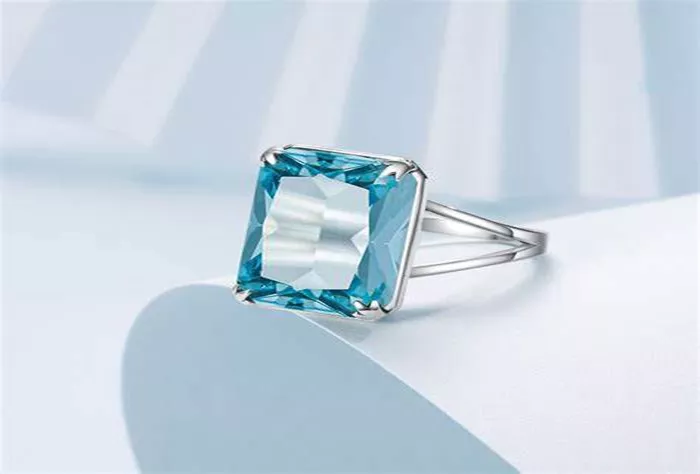Aquamarine is a beautiful blue-green gemstone known for its calming color and durability. Many people love wearing aquamarine rings because of their elegance and meaning. But can you wear an aquamarine ring every day? The answer depends on several factors, including the stone’s hardness, setting, and care requirements.
What is Aquamarine?
Aquamarine is a blue or blue-green variety of the mineral beryl. Its name comes from the Latin words “aqua” (water) and “marina” (sea), meaning “water of the sea.” This gemstone is popular for its soothing color, which ranges from pale blue to deep teal.
Key Properties of Aquamarine
- Color: Light blue to greenish-blue.
- Hardness: 7.5 to 8 on the Mohs scale (good for jewelry).
- Clarity: Usually eye-clean (few visible inclusions).
- Cut: Often faceted to enhance brilliance.
Aquamarine is the birthstone for March and symbolizes courage, clarity, and tranquility. Many people wear it as an engagement ring or fashion statement.
Durability of Aquamarine: Can It Handle Daily Wear?
Before wearing any gemstone daily, you must consider its durability. The main factors are hardness, toughness, and resistance to damage.
Hardness (Resistance to Scratches)
Aquamarine has a hardness of 7.5 to 8 on the Mohs scale, making it harder than many common materials like glass (5.5) and steel (6.5). However, it is softer than diamonds (10), sapphires (9), and moissanite (9.25).
What does this mean?
- It won’t scratch easily from daily activities like typing or handling keys.
- It can still get scratched by harder materials like diamonds or sand (which contains quartz, hardness 7).
Toughness (Resistance to Chipping & Breaking)
Aquamarine has good toughness but is not as strong as diamonds or sapphires. Beryl (the mineral family of aquamarine) can chip if hit hard.
Risks for daily wear:
- Knocking against hard surfaces (like countertops or doors).
- Pressure from heavy lifting or manual work.
- Sudden temperature changes (can cause cracks).
Chemical & Environmental Resistance
Aquamarine is stable under normal conditions but can be affected by:
- Harsh chemicals (bleach, acids, cleaning products).
- Prolonged sunlight exposure (may cause slight fading over decades).
- Extreme heat (sudden temperature changes can cause fractures).
Conclusion on Durability
Aquamarine is durable enough for occasional or light daily wear, but it may not be the best choice for heavy manual work or rough activities. If you work with your hands, consider a more robust gemstone or a protective setting.
Best Ring Settings for Everyday Aquamarine Rings
The right setting can make your aquamarine ring last longer. Here are the best options for daily wear:
Protective Settings (Best for Durability)
Bezel Setting
The gemstone is surrounded by a metal rim.
Protects the edges from chipping.
Great for active lifestyles.
Halo Setting
Small diamonds or gems surround the aquamarine.
Adds extra protection and sparkle.
Low Profile Setting
-
- The stone sits close to the finger.
- Reduces the risk of snagging or impact.
Classic & Elegant Settings (Less Protective but Beautiful)
Prong Setting
Metal claws hold the stone in place.
Shows off the gem’s brilliance.
Higher risk of chipping if hit.
Channel or Pavé Setting
Small stones are set closely together.
Adds sparkle but offers less protection for the center stone.
Metal Choices for Daily Wear
Platinum & White Gold: Strong and scratch-resistant.
Yellow or Rose Gold: Softer but still durable.
Sterling Silver: Affordable but may bend over time.
Best Choice for Everyday Wear: A bezel or halo setting in platinum or gold for maximum protection.
How to Care for an Aquamarine Ring
Even with a protective setting, proper care will keep your ring looking new.
Cleaning Your Aquamarine Ring
- Use mild soap and warm water with a soft brush.
- Avoid ultrasonic cleaners (can loosen settings or damage inclusions).
- Do not use harsh chemicals (bleach, ammonia, acids).
Storing Your Ring
- Keep it in a soft pouch or separate jewelry box to prevent scratches.
- Avoid storing with harder gemstones like diamonds.
When to Remove Your Ring
Take off your aquamarine ring when:
- Doing heavy work (gardening, lifting weights).
- Swimming (chlorine can damage metal).
- Applying lotions or perfumes (chemical buildup).
Professional Check-Ups
- Have a jeweler inspect the setting once a year.
- Ensure prongs are tight to prevent stone loss.
Alternatives to Aquamarine for Everyday Wear
If you love the look of aquamarine but need something tougher, consider:
Sapphire (9 on Mohs Scale)
- Comes in blue and other colors.
- Extremely durable for daily wear.
Moissanite (9.25 on Mohs Scale)
- Nearly as hard as diamond.
- Affordable and sparkly.
Lab-Grown Blue Diamonds (10 on Mohs Scale)
- The hardest gemstone available.
- Scratch-proof and long-lasting.
Final Verdict: Can You Wear an Aquamarine Ring Every Day?
Yes, but with caution. Aquamarine is durable enough for light daily wear if set in a protective design (like bezel or halo). However, if you have an active lifestyle or work with your hands, a harder gemstone like sapphire or moissanite may be a better choice.
Best For:
- Office workers, light daily activities.
- Special occasions or occasional wear.
- Those who love its serene blue color.
Not Ideal For:
- Heavy manual labor (construction, mechanics).
- Frequent exposure to chemicals or impacts.
Conclusion
Aquamarine rings are stunning and durable enough for moderate daily wear, but they require proper care. If you love the gemstone’s beauty, opt for a secure setting and avoid harsh conditions. For those needing a tougher option, sapphires or moissanite offer similar colors with greater durability.
Related Topics:
- The Timeless Elegance of a Diamond and Aquamarine Eternity Ring
- The Timeless Elegance of Diamond and Aquamarine Engagement Rings
- The Allure of the Aquamarine Ring: A Timeless Treasure in the Diamond Store


